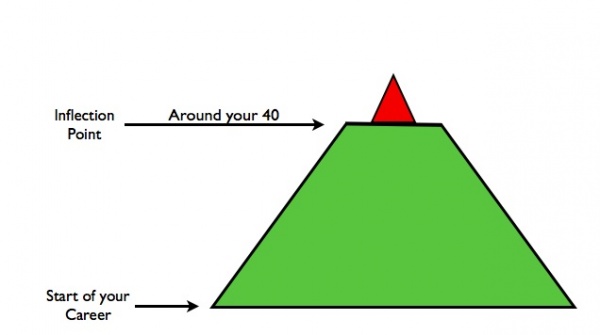
Founder Feedback gives you insight from the startup trenches.
In a post from his blog, Rajesh Setty, author and speaker, explains how oftentimes career development and satisfaction comes to a halt around the age of 40. To combat this, avoid blaming external factors, and instead, re-visit your major career decisions and focus on making the second half of your career just as good, or better than the first.
Below, the article The Inflection Point Around 40 has been republished;
"When I wrote “Beyond Code” (foreword by one of my heroes Tom Peters) in 2005, my research was limited to technology professionals because that was my whole world. My thesis then (I still subscribe to that even today) was that for technology professionals to keep growing, they not only have to be good at “code” but also good at skills “beyond code,” else they will get into a stuck state by the time they are around 40 years old.
Fast forward seven years and I am now convinced that this thesis is applicable across industries.
Let me explain in a bit more detail:
In general, one will enter the world of work before he or she is 25 years old. Yes, there are exceptions but let’s talk in general terms for now. Unless someone is a genius, they have to start at the bottom of the career ladder where he or she has to learn the tricks of the trade and gain “experience” that will make them reach the next rung int he career ladder. Every promotion seems like a career milestone and seems like one is making progress. For the next 15 years or so, these promotions will happen in a certain frequency continuing to give assurance to the person that “progress” is indeed happening.
In parallel, there are life changes happening in the person’s life – marriage, kids, aging parents, buying a home, moving places, health issues here and there, adventures and misadventures and so on. In personal life, the person becomes equally or more accountable than the professional life. As the person gets more experienced, the capacity to perform increases but the capacity to take bold risks decreases because of what’s happening in the personal life.
Then around 40 – something happens. Boom! The person seems like he or she has hit a glass ceiling. Everything seems to come to a halt. In some cases, “work” seems monotonous and the growth is no longer in the horizon. The immediate response internally is that the person has become the victim of something (example: economy) or someone (example: the boss) and that needs to change for the person’s situation to change. Now we have an external dependency that is driving the internal happiness. Once this “blame that external factor” virus hits the person, there is no antibiotic that will take the person out of that condition.
Take a look at the following triangle (with a twist of course)

Think of the above is a typical career ascent triangle. At the bottom of the triangle there are TON of people similar skills – more importantly similar capacities to perform. As the person moves up the triangle, there are less and less people who are in that position of power. As the person moves closer to the top, the number of people decrease drastically. Around 40, the person has close to 15 years of experience and senior enough to take on some serious leadership position – a position where the needle can move one way or the other based on the person’s decisions. Those kinds of positions are “high stake” positions for the organization. The surprise for some is that how few those positions are in any organization. At the inflection point, the number of such positions shrink to disproportionately smaller numbers than what the person could have imagined.
Another surprise – what it takes to make the “jump” are skills and accomplishments (providing proof that the person is qualified) that should have been developed over the 15 years career and not something that the person can pick up overnight. So if the person does not make the “jump,” he or she is simply paying the price for the sum of all the “not so optimal” career decisions the person has made throughout his or her career.
The point: For those of you who are still young, know that the inflection point is coming sooner than later and revisit your every career decision from now on. For those of you who have crossed the inflection point, stop blaming the “external factors” as it’s a serious “cop out” strategy – you might as well take the lion’s share of the responsibility and make something happen in your second half of the career.
All the best!"
For more startup insights from Rajesh, check out more from his blog, follow him on Twitter @rajsetty, or register for the Spring 2013 Silicon Valley Founder Institute, where he serves as a mentor.
Like this article?
Subscribe to our Weekly NewsletterAttend a Free Startup Event



